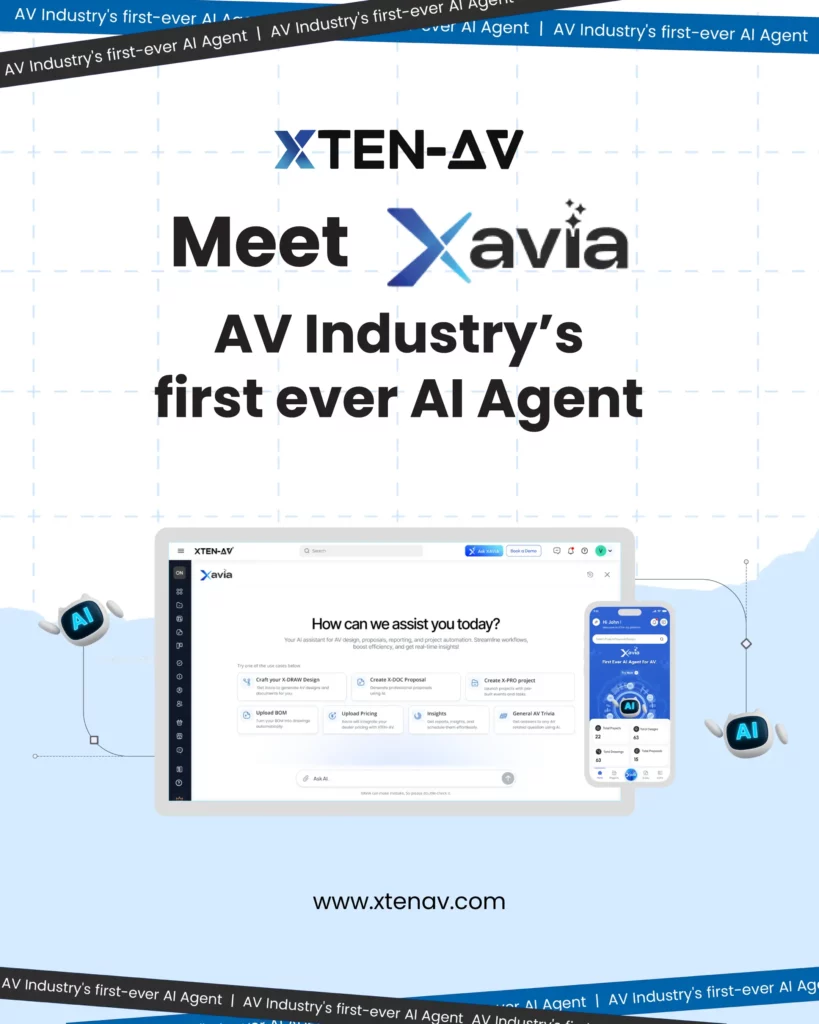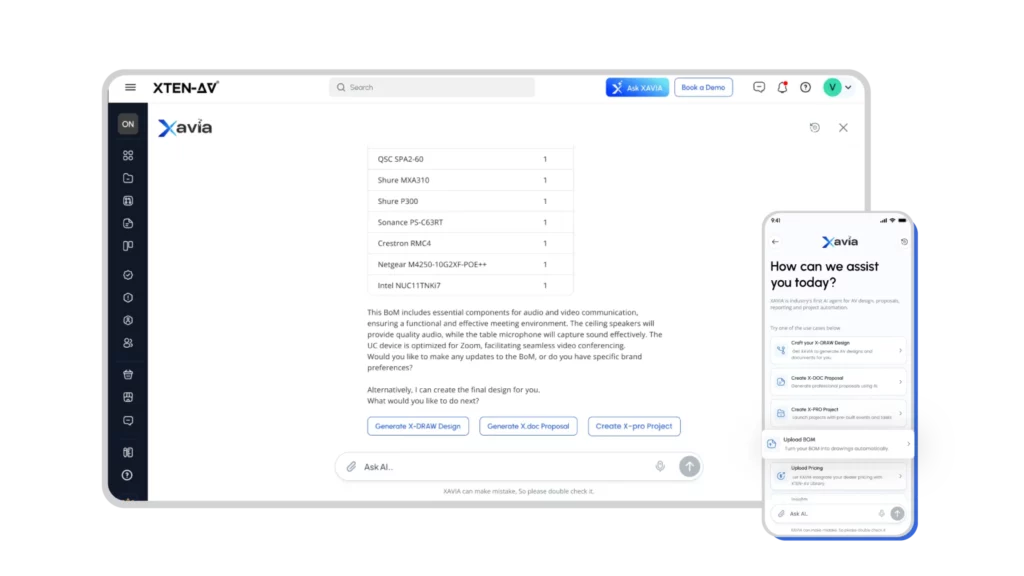From Hours to Minutes, and Now to Seconds: How XTEN-AV XAVIA AI is Changing the AV Industry

AV design used to be a grind. Endless meetings just to gather basic requirements. Hours lost to pen and paperwork, clunky interfaces, and manual calculations that left too much room for human error. AV Designers spent days revising layouts, changing line schematics, and chasing approvals. It was a tedious process. It demanded patience, precision, and a whole lot of caffeine.
But that world? It’s gone.
Welcome Xavia, the AV industry’s first-ever AI agent that doesn’t just make your work easier, it transforms it. This AI-powered AV design software automates everything from system design and proposals to project management, all while delivering smart BOM recommendations, real-time insights, and instant reports. With intelligent system logic, sleek chat and voice-enabled interaction, and automation at its core, Xavia has collapsed the AV project timeline from hours to seconds. From the initial concept to a polished, client-ready proposal, the entire AV project now flows with unprecedented speed, precision, and intelligence.
Remember when designing AV systems took hours? That’s all in the past now.
The Traditional World of AV Design
Before platforms like Xavia entered the picture, the AV industry was troubled by inefficiency. Every new AV project started with a barrage of meetings, long email threads, and endless document sharing just to align on the scope. Once that was done, the real hustle began.
AV designers had to manually translate those requirements into technical schematics, often juggling three to four tools just to produce a halfway-decent output. Signal flow diagrams, product selection, and cabling specs all had to be checked manually. Meanwhile, AV system integrators would wait on designs and documentation to move forward with execution, often working with outdated or incomplete information.
One small change in requirements? Back to square one. Timelines stretched. Costs inflamed. Frustrations mounted.
And yet, this was accepted as “normal.”
There was no unified system. No real-time insights. No intelligent assistant that could adapt on the fly. Just spreadsheets, PDFs, and a lot of human juggling.
It wasn’t just inefficient, it was unsustainable.
The Tipping Point: Why Change Was Inevitable
The demands of the AV industry have grown exponentially in recent years. Clients now expect immersive, fully integrated AV solutions delivered on tighter and tighter timelines, with zero room for error. At the same time, AV technology has become more advanced, more specialized, and more nuanced, forcing design teams to keep pace with a constantly evolving landscape of standards, products, and protocols.
But the reality? AV designers and system integrators simply haven’t had the tools to keep up. Instead, they’ve been forced to rely on a patchwork of generic software that wasn’t built for the AV industry. From spreadsheets and slide decks to project management platforms and CAD tools, none of them talk to each other. The result? Fragmented workflows, constant tool-switching, and endless back-and-forth between teams that slows everything down.
Data gets scattered across platforms and buried in email threads. Collaboration breaks. Visibility is lost. And the pressure to deliver flawless AV projects faster than ever? That never stops.
This pressure exposed a growing gap in traditional workflows. Teams were overworked. Systems were disjointed. And the cracks began to show.
Worse still, the talent shortage hit hard. Skilled AV designers and engineers became increasingly scarce, putting even more strain on those still in the field.
And while other industries embraced automation, machine learning, and artificial intelligence, AV lagged behind.
The result? An urgent, industry-wide realization: the old way of working simply couldn’t support the complexity, scale, and speed the modern AV world demands.
Now, what? Enter Xavia.
Introducing XTEN-AV's XAVA: AV Intelligence at Light Speed
Powered by advanced AI models, Xavia acts as your go-to AI agent, ready to assist you via chat or voice, anytime you need. It’s smart, fast, and deeply fluent in AV design, signal flow, product compatibility, and project requirements. But that’s just the beginning. Xavia handles proposals, project management, BOM recommendations, and delivers real-time insights and reports, all in one place.
This isn’t just intelligent assistance—it’s end-to-end automation. For AV system integrators, that means no more juggling between tools, teams, or timelines. You can now complete an entire AV project, from concept to post-sales delivery, by simply clicking the ‘Ask Xavia’ button and telling it what you need. One platform. One command. Total execution.
With Xavia, here’s what you get:
- Instant product recommendations customized to your project’s technical needs and user goals
- Fully automated designs generated with built-in AI logic
- Beautiful, smart proposals created in seconds, which are client-ready and brand-polished
- Actionable project insights delivered on demand
- AI-managed task planning and progress tracking, turning chaos into clarity
- Easy to access via web and mobile, through chat
This isn’t just automation. It’s intelligence, designed specifically for AV system integrators, project managers, and design consultants who need to move faster, smarter, and with less friction.
AV Automation with XAVIA = From Hours to Seconds!
- Automate AV Drawings, Proposals & Reports in Seconds
- AI-Powered Search, Dealer Pricing & Task Suggestions
- Auto-Generate Rack Layouts, Cable Schedules & Diagrams
- Get Smart Product Recommendations from 1.5M+ Items
- Chat or Speak to XAVIA — Your AI Assistant for AV
- Works with X-DRAW, x.doc & Project Management Tools
Real Impact on AV Project Workflow: From Hours to Minutes to Seconds
Let’s talk results.
Before Xavia, designing a mid-sized AV project could take anywhere from 20 to 40 hours of labor between discovery, design, documentation, and coordination. With Xavia, that same process happens in seconds.
Yes, seconds.
You input your requirements, such as room size, application type, preferred brands, and XAVIA AI assistant does the rest. It pulls from a dynamic, up-to-date catalog of products, runs internal design logic, and produces complete AV schematics. Diagrams, layouts, bills of materials, and even quotes that are ready for review, editing, and delivery.
But it doesn’t stop there.
Xavia also offers AI-managed task tracking, helping teams stay aligned on timelines, deliverables, and project health. Project management is going to become proactive with the AI identifying risks, flagging delays, and suggesting actions.
For AV designers, this means less time on repetitive tasks and more time spent refining user experiences. This means more time for exploring creative possibilities and building strategic value.
And for integrators? It’s a boon. Projects move faster. Margins improve. Clients are happier.
That’s not evolution. That’s revolution.
Beyond Speed: Empowering Creativity and Execution
Xavia’s real power isn’t just in time-saving, it’s in liberating talent.
By offloading the repetitive, technical grunt work to AI, Xavia allows AV professionals to operate at a higher level. They’re no longer stuck redrawing signal paths or reworking spreadsheets. They can now think bigger, innovate faster, and make strategic decisions that move the project forward.
It’s the perfect balance of creativity and execution.
Want to test a new layout idea? Just ask Xavia. Need to swap products based on availability or budget? One click. Looking for an alternative design strategy that better suits your client’s space? Xavia offers options instantly.
With Xavia’s AI assistance always by your side, your team becomes more agile, more strategic, and more impactful.
This is what the future of AV design looks like: fluid, intelligent, and human centered.
AV Designers + XAVIA AI Agent: A Boon That’s Just Beginning
As Xavia becomes more widely adopted, it’s going to spark a heated debate across the AV industry, rightfully so. Anytime a radical AI-powered design software enters the scene, questions will follow. Some will wonder if tools like Xavia are automating too much. Others will ask: What does this mean for the role of the AV designer?
The fear is understandable, but the future looks far more promising than precarious.
Rather than replacing AV designers, Xavia is going to uplift them. By eliminating tedious, time-consuming tasks, manual calculations, diagram revisions, and spec validations, Xavia will free up designers to focus on what they do best: creativity and execution.
Their role will evolve into something more strategic. Less about technical grunt work, and more about solving complex challenges, guiding clients. It is going to craft AV solutions that scream – ‘this is peak user experience.’
Designers will become consultants, strategists, collaborators, and creators, with Xavia acting as their AI assistant.
Yes, the industry will debate. Some will resist. But over time, it’s going to become clear: Xavia isn’t a threat to the AV designer’s role. It’s an upgrade for their talent.
This is a boon, not just for individual professionals but for the entire AV ecosystem. And the best part? It’s only just beginning. There is so much to it as the technology advances.
The Future Is Measured in Seconds
The story of the AV industry has always been one of innovation. From analog systems to digital transformation, the industry has evolved in the past, too. But never this quickly!
Xavia marks a new chapter.
We’ve moved beyond efficiency. We’re now in the era of AI-powered creativity, where entire AV projects are conceived, designed, and launched in record time. Where intelligence works hand-in-hand with human skill to deliver AV solutions that are not just fast, but exceptional.
The future is here, and it’s measured in seconds.
Ready to Experience It?
Want to see how fast your next project can really move? Try Xavia today! On web or mobile, by chat or voice, discover the power of AI in AV design.
The clock is ticking. Why stay stuck in hours when seconds will do?

